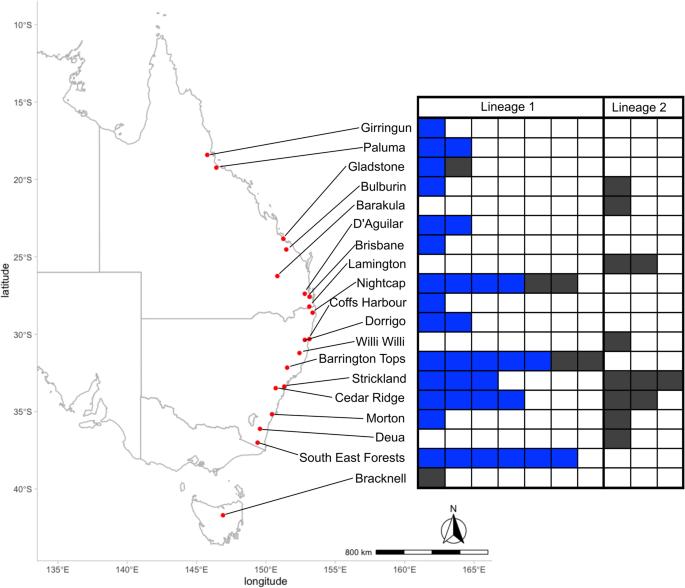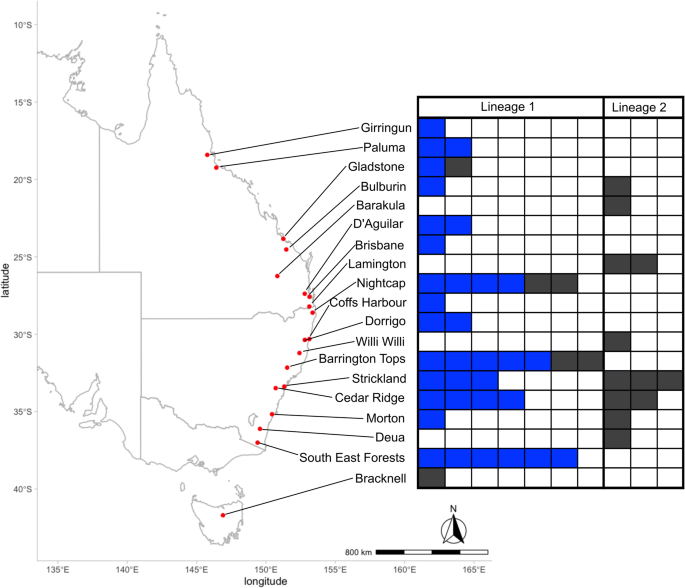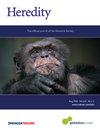Two sympatric lineages of Australian Cnestus solidus share Ambrosiella symbionts but not Wolbachia
IF 3.1
2区 生物学
Q2 ECOLOGY
引用次数: 0
Abstract
Sympatric lineages of inbreeding species provide an excellent opportunity to investigate species divergence patterns and processes. Many ambrosia beetle lineages (Curculionidae: Scolytinae) reproduce by predominant inbreeding through sib mating in nests excavated in woody plant parts wherein they cultivate symbiotic ambrosia fungi as their sole source of nutrition. The Xyleborini ambrosia beetle species Cnestus solidus and Cnestus pseudosolidus are sympatrically distributed across eastern Australia and have overlapping morphological variation. Using multilocus sequencing analysis of individuals collected from 19 sites spanning their sympatric distribution, we assessed their phylogenetic relationships, taxonomic status and microbial symbionts. We found no genetic differentiation between individuals morphologically identified as C. solidus and C. pseudosolidus confirming previous suggestions that C. pseudosolidus is synonymous to C. solidus. However, within C. solidus we unexpectedly discovered the sympatric coexistence of two morphologically indistinguishable but genetically distinct lineages with small nuclear yet large mitochondrial divergence. At all sites except one, individuals of both lineages carried the same primary fungal symbiont, a new Ambrosiella species, indicating that fungal symbiont differentiation may not be involved in lineage divergence. One strain of the maternally inherited bacterial endosymbiont Wolbachia was found at high prevalence in individuals of the more common lineage but not in the other, suggesting that it may influence host fitness. Our data suggest that the two Australian Cnestus lineages diverged allopatrically, and one lineage then acquired Wolbachia. Predominant inbreeding and Wolbachia infection may have reinforced reproductive barriers between these two lineages after their secondary contact contributing to their current sympatric distribution.


澳大利亚坚脊线虫的两个同域谱系共有Ambrosiella共生体,但没有沃尔巴克氏体。
近亲繁殖物种的同源谱系为研究物种分化模式和过程提供了极好的机会。许多安布罗西亚甲虫谱系(Curculionidae:Scolytinae)通过在木本植物部位挖掘的巢穴中进行同胞交配,通过主要近亲繁殖繁殖,在那里它们培养共生的安布罗西娅真菌作为唯一的营养来源。木犀金龟甲和拟金龟甲共同分布在澳大利亚东部,具有重叠的形态变异。通过对从19个同域分布位点收集的个体进行多点测序分析,我们评估了它们的系统发育关系、分类地位和微生物共生体。我们发现在形态上被鉴定为C.solidus和C.pseudo-solidus的个体之间没有遗传分化,这证实了之前关于C.pseudo solidus与C.solidus同义的说法。然而,在C.solidus中,我们意外地发现了两个形态上无法区分但基因上不同的谱系的同域共存,它们的细胞核较小,线粒体分化较大。在除一个位点外的所有位点,两个谱系的个体都携带相同的初级真菌共生体,一种新的Ambrosiella物种,这表明真菌共生体的分化可能与谱系分化无关。在更常见谱系的个体中发现了一种母系遗传细菌内共生体沃尔巴克氏体菌株的高患病率,但在另一种中没有发现,这表明它可能会影响宿主适应性。我们的数据表明,澳大利亚的两个Cnestus谱系在异地分化,其中一个谱系随后获得了沃尔巴克氏体。在二次接触后,主要的近亲繁殖和沃尔巴克氏体感染可能加强了这两个谱系之间的生殖障碍,这有助于它们目前的同域分布。
本文章由计算机程序翻译,如有差异,请以英文原文为准。
求助全文
约1分钟内获得全文
求助全文
来源期刊

Heredity
生物-进化生物学
CiteScore
7.50
自引率
2.60%
发文量
84
审稿时长
4-8 weeks
期刊介绍:
Heredity is the official journal of the Genetics Society. It covers a broad range of topics within the field of genetics and therefore papers must address conceptual or applied issues of interest to the journal''s wide readership
 求助内容:
求助内容: 应助结果提醒方式:
应助结果提醒方式:


